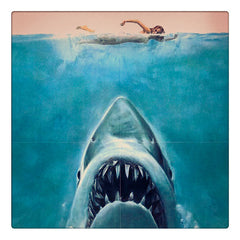Summer Cinema: Jaws, 1975

Maybe skip the water altogether this weekend.
There’s nothing worse than working while everyone else is away on vacation. Not only are you picking up the slack for your coworkers, but some have the nerve to send those “Wish you were here” postcards back to the office just to rub your nose in it. But don’t let sour grapes ruin your day. Maybe all you need is a reminder that beach vacations aren’t all they’re cracked up to be. Jaws will help you feel better about skipping the beach.
From the beginning, Jaws was set to attack. The book by Peter Benchley generated a lot of early attention, and the film rights were purchased even before it was published in 1974. By the time the film came out in the summer of 1975, the book had sold over five and a half million copies, and the film would later go on to become the highest grossing film in history to that point. But from the beginning of the production, the film was in deep water.
Producers chose a 26-year-old director who was coming off the success of his first feature film. However, Steven Spielberg was naïve enough to eschew filming outdoor scenes in a Hollywood tank, opting instead for the waters off Martha’s Vineyard. Shooting on the ocean caused numerous problems, not the least of which was a ship that starting sinking with all three primary cast members on board. Trouble extended to everything in the water, too. The film’s extensive effects and expensive sharks pushed the film way over budget, especially as the three sharks built were constantly malfunctioning. The crew go to calling the production “Flaws” after the problematic mechanical sharks (one of which sank on its first day in the water).
Furthermore, filming began without a complete script, since Spielberg was unhappy with the first two acts of the book and the film was still being rewritten on location. Each scene was finished the night before it was to be shot, with cast and crew not exactly sure what to expect for the next day’s filming. What’s more, actor Robert Shaw who played the film’s shark hunter would fly to Canada as soon as his scenes were shot, in order to avoid the US tax authorities, but when he was on set he spent most of his time drinking and arguing with Richard Dreyfuss.
All of these problems caused the film to get way, way behind schedule: They were scheduled for 55 days of shooting, but finally wrapped after 159 days. Forget the shark, the studio must have been out for blood!
There seems to have been a silver lining to all of this, however, and some of these problems might have made for a better film. Spielberg’s insistence on shooting on location rather than a tank made all the difference in the overall quality of the film, with the scenes on the water especially naturalistic and believable. Problems with the shark meant that the mechanical props had to sometimes be done away with altogether, and attack scenes show from the shark’s perspective instead. Film critics agree that this technique is what makes the film so suspenseful and the reason the film’s popularity is so enduring. Finally, rewriting the script on set meant it was possible for many people to collaborate, and the film’s most famous line (“You’re going to need a bigger boat”) was contributed by actor Roy Scheider.
Still, as good as the film is, Jaws does not make you want to rush out and book a beach holiday. Overall beach attendance was down in 1975, and I think it’s fair to attribute some of that to people who saw the film. So when it seems like everyone else is away on vacation and you’re stuck at the office, Jaws might just make you feel better about being on dry land.
Did you know? The crew nicknamed the shark “Bruce” after the name of Spielberg’s lawyer.